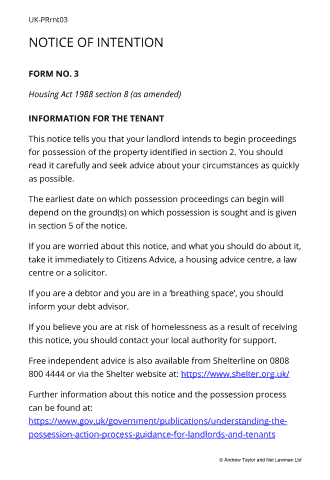Section 8 Notice (notice to quit form)

Document overview

 England & Wales
England & Wales

- Length:13 pages (1360 words)
- Available in:
 Microsoft Word DOCX
Microsoft Word DOCX Apple Pages
Apple Pages RTF
RTF

If the document isn’t right for your circumstances for any reason, just tell us and we’ll refund you in full immediately.

We avoid legal terminology unless necessary. Plain English makes our documents easy to understand, easy to edit and more likely to be accepted.

You don’t need legal knowledge to use our documents. We explain what to edit and how in the guidance notes included at the end of the document.

Email us with questions about editing your document. Use our Lawyer Assist service if you’d like our legal team to check your document will do as you intend.

Our documents comply with the latest relevant law. Our lawyers regularly review how new law affects each document in our library.
About this document
Use this Section 8 Notice to terminate an assured shorthold tenancy agreement during the fixed term when the tenant has breached one or more of the obligations in the tenancy agreement. The most common reason will be for late payment, or non payment of rent.
As of 29 August 2020, the Government has amended the Coronavirus Act 2020, introducing various new notice requirements when serving a Section 8 notice. The form is updated to reflect the latest changes. The latest form also takes account of any extension under the Debt Respite Scheme (Breathing Space Moratorium and Mental Health Crisis Moratorium) (England and Wales) Regulations 2020.
The notice complies with the Housing Act 1988 and the Housing Act 1996.
When to use this form
This notice is suitable for a landlord looking to terminate an assured shorthold tenancy agreement for a property in England or Wales.
A landlord cannot evict a tenant without obtaining a court order for possession first. Before applying to court, he or she must have served a specific form of notice on all tenants.
The grounds under which the landlord may serve a notice to quit are laid out in the Housing Act in detail. We have included a full list in the guidance notes to this document alongside the explanatory notes on how to complete the notice. The most common reasons for serving a this type of notice are non-payment or late payment of rent, damage to the property or its contents, or disturbance of neighbours and other local residents. However, it can be used in the case of any breach of agreement and several other more esoteric cases as well.
If the tenancy is at an end and the landlord seeks possession, then a s21a notice should be used if the tenancy started before 1 October 2015, or a Form 6a if it started after.
A Section 8 notice is only suitable if the fixed term of the tenancy has not ended.
The notice period required before the tenant can be evicted depends on the grounds for eviction and varies between two weeks and two months (except in the case of antisocial behaviour).
Serving this notice does not mean that the landlord must take the tenant to court. It can be used as an effective warning to the tenant that the agreement has been breached and that if there is a further breach you may take action.
Features
- Recognised by courts: follows the official prescribed format
- Can be used to warn tenants that you recognise a breach of agreement
- Use to obtain a possession order and a money order
- Includes prescribed 'guidance notes for landlords and tenants' required to provide to the tenant when serving the completed form.

Recent reviews
I would recommend you. The form did what it says on the tin.
Choose the level of support you need
Document Only
This document
Detailed guidance notes explaining how to edit each paragraph
Lawyer Assist
This document
Detailed guidance notes explaining how to edit each paragraph
Unlimited email support - ask our legal team any question related to completing the document
- Review of your edited document by our legal team including:
- reporting on whether your changes comply with the law
- answering your questions about how to word a new clause or achieve an outcome
- checking that your use of defined terms is correct and consistent
- correcting spelling mistakes
- reformatting the document ready to sign
All rights reserved
